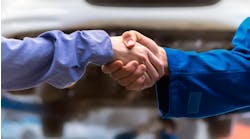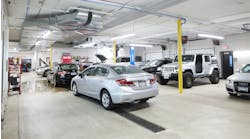During a recent trip to El Salvador, I got my first look at the automotive culture of an "emerging nation." The country is preparing to enter the world labor market, and though it has a very long way to go, things already are beginning to change. And where there are jobs, there are commuters.
Many people travel by bus, which mostly are retired school buses imported from the United States. The buses are brightly painted and decorated with a strange mixture of religious scenes and chrome accessories that look like they're out of an old J.C. Whitney catalog. About a third of all the vehicles I saw were motorcycles, mostly small 4-stroke singles from Korea and Japan. Police ride dual-sport bikes with what looks like a 600cc V-twin mounted sideways in the frame, like a Moto Guzzi.
There are only 6 million people in El Salvador, but it seems every car manufacturer in the world is anticipating a burgeoning market. In the capital city of San Salvador, I saw dealers for every OEM we see here, plus Peugeot, Renault, Fiat, Seat, Daihatsu, Chery (the Chinese company that wants to break into the U.S. market) and a few more I didn't recognize.
Occasionally I saw an Explorer or Suburban, but the new car market in El Salvador consists almost entirely of the least expensive models in a manufacturer's lineup. I suppose this and the currency exchange rate (El Salvador's economy runs on the U.S. dollar) give the Asian companies an advantage, because most of the cars I saw — new or old — were from Hyundai, Toyota or Mitsubishi. Although I saw few that are smaller than what we see here in the U.S., there were no full-size models either — not even pickup trucks. Passenger vans are about two-thirds the size of our minivans, but they still manage to fit 12 seats inside. Most of those are used as buses-for-hire.
Fuel prices are about a dollar a gallon higher than here. Leaded gasoline is still available, but most cars are newer than 1992 (when the country's civil war ended), and they do have catalytic converters.
However, it seems most of the country runs on diesel fuel, and there are no diesel emission controls of any kind. The city's buildings are stained with soot, and in the daytime when traffic is heavy, visibility is obscured by a haze of diesel smoke. The constant stench and irritation made me thankful for our own EPA. I can't imagine the government of El Salvador ever regulating diesel emissions, but if the country's entry into the world economy is successful, cleaner engines may eventually become more common.
In a culture of self-reliance and a fledgling post-war economy, improvisation is an important life skill in El Salvador, especially for mechanics. I saw some modern-looking shops in San Salvador, and iATN lists six members there. But judging by the vehicles I saw outside the city, the mechanics are equal parts blacksmith and magician. Bad roads and constant overloading take a heavy toll on small cars and trucks, and some repairs and modifications I saw were imaginative and positively brilliant.
I never saw a car abandoned or broken down on the side of the road, but I didn't recognize that fact until I came home and saw both on the way home from the airport. It's funny how that made me recognize how wealthy we are in this country.




